They say all you need to light a stage is a candle and talent, but the
invention of electricity was a big help. Light sources today are electric
and there are three basic types: incandescent lighting, discharge lighting
and LEDs. Below is a general introduction, and of course much more detail
is easily available elsewhere on the Internet.
|
Incandescent Lamps:
|
- Principle:
All incandescent lamps work by sending an electric current
through a metal wire called a filament. The metal resists
the passage of current, and in so doing it gives off heat,
and if it gets hot enough it gives off light. The wire is
placed in a transparent glass envelope in order to keep out
oxygen; otherwise it would just burn. Originally there was
a vacuum inside. However if the filament is hot enough to
give out light, eventually due to heat it will evaporate,
so the bulb is filled with a gas which conducts away some
of the heat and slows down evaporation. When enough bits
of filament evaporate from the same part of the wire, a gap
is formed in the wire and it can't conduct the current, and
so the lamp burns out.
- Traditional Incandescent:
Household incandescent bulbs usually have a pear shape, and
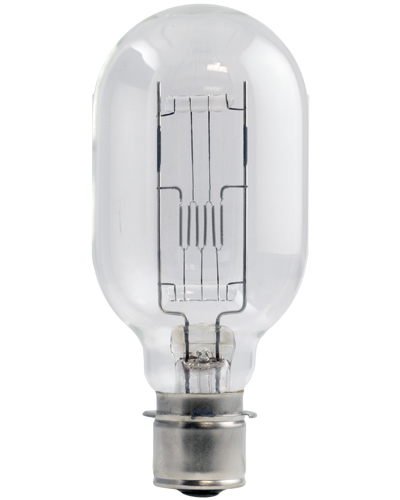 the filament usually forms part of a circle, so that it can
emit light in all directions and flood the room. The bulb
is filled with an inert gas such as argon. In theater
lighting we usually need the light to be focused in one
direction only, so that it goes to the reflector and the lens,
and not to the sides, so theater lamps were manufactured with
the filament in the shape of a plane, parallel to the lens and
reflector planes. If you look closely at the filament you'll
see that it's not a simple wire but rather a coil. In fact,
it's a coil which is then coiled round itself, to make it burn
hotter, and the coiled wire is then put in a plane shape. Household
lamps might have a rated average lifetime of about 800 hours,
but in the theater lifetime is less important than intensity,
so theater lamps are made to run at a hotter temperature,
even though that means a shorter lifetime, generally about
200 hours.
the filament usually forms part of a circle, so that it can
emit light in all directions and flood the room. The bulb
is filled with an inert gas such as argon. In theater
lighting we usually need the light to be focused in one
direction only, so that it goes to the reflector and the lens,
and not to the sides, so theater lamps were manufactured with
the filament in the shape of a plane, parallel to the lens and
reflector planes. If you look closely at the filament you'll
see that it's not a simple wire but rather a coil. In fact,
it's a coil which is then coiled round itself, to make it burn
hotter, and the coiled wire is then put in a plane shape. Household
lamps might have a rated average lifetime of about 800 hours,
but in the theater lifetime is less important than intensity,
so theater lamps are made to run at a hotter temperature,
even though that means a shorter lifetime, generally about
200 hours.
- Tungsten Halogen:
Nearly all theater incandescent lamps today are of this kind.
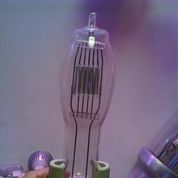 Regular incandescent bulbs burn out because the heat causes
bits of filament evaporate (though this is slowed down by
gas pressure). Tungsten halogen lamps, on the other hand,
are filled not with inert gas but rather with one of the
halogen gases — iodine or bromine (Indeed, in the
early days of this technology, tungsten halogen lamps were referred
to as "quartz iodine", because of the iodine gas and the quartz
used in the glass bulb. Even today, some people refer to them as
"quartz.") When a bit of filament evaporates, it combines with
molecules of the gas to form a compound, eventually molecules
of the compound are drawn back to the filament and the bits
of filament then redeposit on the wire. Why doesn't this
lead to eternal life for the bulb? Because the bits of
filament don't necessarily go back to the same place they
came from, and eventually there will still be a gap in the
wire...and the lamp burns out. Still, lamp life is far
longer than that of the traditional incandescent bulbs.
However - as I said, lifetime is not as important for theater
lamps. So rather than giving the new lamps longer life,
they were made to give brighter and whiter light and a
more compact light source, which makes for far more
accurate optics. Mirrors and lenses need a point source to
be absolutely precise, and the smaller the light source,
the closer it is to a point, and the more light can be
utilized efficiently. In addition, a Fresnel or PC with a
physically smaller lamp will have a larger range of beam
size, because there's more room to move the lamp further
from or closer to the lens. So the lamps are made much
smaller, at the expense of the extra lifetime.
Tungten halogen lamps are also made to burn hotter than do
Regular incandescent bulbs burn out because the heat causes
bits of filament evaporate (though this is slowed down by
gas pressure). Tungsten halogen lamps, on the other hand,
are filled not with inert gas but rather with one of the
halogen gases — iodine or bromine (Indeed, in the
early days of this technology, tungsten halogen lamps were referred
to as "quartz iodine", because of the iodine gas and the quartz
used in the glass bulb. Even today, some people refer to them as
"quartz.") When a bit of filament evaporates, it combines with
molecules of the gas to form a compound, eventually molecules
of the compound are drawn back to the filament and the bits
of filament then redeposit on the wire. Why doesn't this
lead to eternal life for the bulb? Because the bits of
filament don't necessarily go back to the same place they
came from, and eventually there will still be a gap in the
wire...and the lamp burns out. Still, lamp life is far
longer than that of the traditional incandescent bulbs.
However - as I said, lifetime is not as important for theater
lamps. So rather than giving the new lamps longer life,
they were made to give brighter and whiter light and a
more compact light source, which makes for far more
accurate optics. Mirrors and lenses need a point source to
be absolutely precise, and the smaller the light source,
the closer it is to a point, and the more light can be
utilized efficiently. In addition, a Fresnel or PC with a
physically smaller lamp will have a larger range of beam
size, because there's more room to move the lamp further
from or closer to the lens. So the lamps are made much
smaller, at the expense of the extra lifetime.
Tungten halogen lamps are also made to burn hotter than do
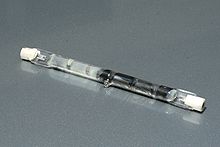 traditional incandescents. Since ordinary glass would not withstand the
greater heat,the envelope is quartz. If the bulb is touched directly,
and not with paper, cloth, or protective glove, skin oil is deposited
on the quartz and when the bulb heats up, that part of the glass will
expand into a bubble and eventually crack. If touched, the
bulb should be cleaned with alcohol
and allowed to dry before the lamp is used.
traditional incandescents. Since ordinary glass would not withstand the
greater heat,the envelope is quartz. If the bulb is touched directly,
and not with paper, cloth, or protective glove, skin oil is deposited
on the quartz and when the bulb heats up, that part of the glass will
expand into a bubble and eventually crack. If touched, the
bulb should be cleaned with alcohol
and allowed to dry before the lamp is used.
- Dimming:
All incandescent lights are dimmed by reducing the current
that goes through the wire. Dimming has a significant effect
on lamp life: a 5% reduction in voltage will double lamp
life, while reducing light output by about one fifth.
|
|
Discharge Lamps:
|
- Principle:
Like incandescents, discharge lamps are filled wih gas, but
they do not have a filament. If a high voltage is applied
to the gas, electrons are knocked off of the atoms of the
gas. The gas is then full of positive ions and electrons,
which are attracted to electrodes at the opposite ends of
the lamp. After the initial push of the high voltage, the
gas will keep on conducting current because the moving
charged particles then bang into other atoms and knock
electrons off of them, too.
In some cases when they bang into an atom they aren't going
fast enough to knock off its electrons, but the "banging"
gives energy to the atom, thus raising its outer electrons
to a higher level. As those electrons fall back down to the
original level, they emit that extra energy in the form of
light. The color of the light depends on the type of
gas (specifically it depends on the size of the energy gap
in the gas). Discharge lamps often are filled with a mixture
of gases and the dominant one is responsible for the color.
Discharge lamps can be low or high pressure. In low pressure
lamps the charged particles move a relatively long distance
before banging into another atom, meantime building up enough
speed so that when they do bang into it, they knock off
electrons. In high pressure lamps there are more collisions
and so the gas gets hotter. This causes electrons to be
excited to higher energy levels before being knocked off
at higher energy levels, changing the color of the gas.
Light from discharge lamps does not have a continuous
spectrum like incandescent lamps, but rather the light is
produced at discrete bands of the spectrum.
- Types of Lamps
There are various types of
discharge lamps, characterized
by the type of gas that fills them:
- Fluorescent:
This is the most common type of discharge lamp, found
in many homes and offices. Household fluorescents
are filled with mercury at low pressure, which
produces invisible ultra-violet light. The inside
of the tube is coated with phosphor, which converts
the UV to visible light. Fluorescent lamps are
available in different shades of white (daylight,
cool white, warm white) whose different colors are
due to the combination of phosphors on the envelope.
They were originally (and still are) manufactured
as tubes, but today, compact fluorescents ("CFL")
are also common
and are found with a screw base identical to the
household incandescent. Fluorescent light is
generally cooler (in color) than incandescent light.
Dimming: Fluorescent
lamps can be dimmed, but generally a special circuit
needs to be added in series with the dimmer. The
basic idea is that the current going through the
lamp can only be reduced after the arc has been
struck (that is, the first push of current has
caused ionization to begin). This used to involve
preheat transformers, but today, electronic control
makes it easier. Sometimes it's possible to connect
a fluorescent to a regular dimmer with a "ghost"
load (a conventional incandescent located in an
unobtrusive place). Before the show the dimmer is
brought sharply up to full, and afterwards not
allowed to go below about 10% of maximum intensity,
so that the gas remains warm. How well this works
depends on the particular dimmer circuit, and it's
better, if possible, to use a specialized
fluorescent dimmer.
- Sodium Vapor:
Sodium vapor lamps give off yellow light, and come in
two types: high pressure (HPS) and low pressure
(LPS). Low pressure sodium gives off an almost
completely monochromatic light! This means that
the only colors you will see under such light are
white and yellow. This can be used to fascinating
effect. I once saw a performance of the Sleeping
Beauty where at the ball, after the witch cast
her spell, incandescent lighting with the same
tint as sodium was slowly replaced by low
pressure sodium lamps. It looked as if the
colors just drained out of all the costumes as the
spell did its work.
- Mercury vapor:
Mercury is often used with a mixture of gases, for
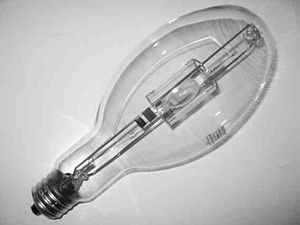 example metal halide lamps contain mercury along
with halides (compounds of metals with bromine or
iodine). All these lamps have a bluish color,
which is modified by the other gases in the
mixture. Generally lamps with initials ("HMI", "CID", "CSI")
are of this type. These discharge lamps are used in
most high intensity follow spots. Like most discharge lamps,
they can't be electrically
example metal halide lamps contain mercury along
with halides (compounds of metals with bromine or
iodine). All these lamps have a bluish color,
which is modified by the other gases in the
mixture. Generally lamps with initials ("HMI", "CID", "CSI")
are of this type. These discharge lamps are used in
most high intensity follow spots. Like most discharge lamps,
they can't be electrically
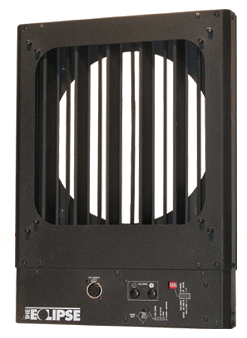 dimmed. In the theater they are generally dimmed
mechanically, with a "venetian blind" type shutter
in front of the instrument lens, or an internal
shutter in some follow spots.
HMI Fresnels originally used in film are now used
in theater, dance, and opera when a very powerful
single source is desired.
dimmed. In the theater they are generally dimmed
mechanically, with a "venetian blind" type shutter
in front of the instrument lens, or an internal
shutter in some follow spots.
HMI Fresnels originally used in film are now used
in theater, dance, and opera when a very powerful
single source is desired.
- Xenon:
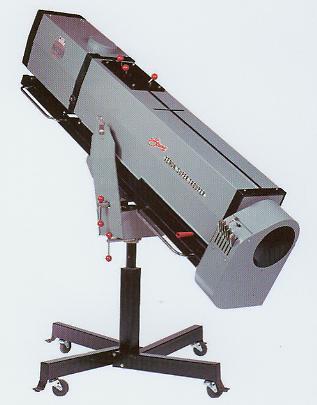 Extremely powerful follow spots, such as the Strong Super
Extremely powerful follow spots, such as the Strong Super
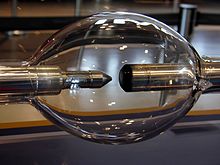 Trouper, have Xenon lamps. These are always
at high pressure, give off a bluish white light,
and, because of the high pressure, extreme care
must be used when handling the lamp.
Xenon lamps for follow spots are usually supplied
with protective goggles and plastic gloves to be
used when changing the bulb, and the lamps should
never be changed or otherwise handled by untrained
personnel.
Trouper, have Xenon lamps. These are always
at high pressure, give off a bluish white light,
and, because of the high pressure, extreme care
must be used when handling the lamp.
Xenon lamps for follow spots are usually supplied
with protective goggles and plastic gloves to be
used when changing the bulb, and the lamps should
never be changed or otherwise handled by untrained
personnel.
- Neon:
Commercial neon lights, used in signs and advertising,
use a very high voltage of several thousand volts.
They aren't all actually filled with neon gas; the
red ones have neon gas, yellow have helium, blue
have mercury. There is a related lamp, also called
"neon", which is very small, and used as an indicator
light, for control panels on boilers for example,
and as circuit testers; this is actually called a
neon glow lamp and contains neon gas at low pressure.
In theory, dimming is the same as with other discharge
lamps, but in practice I've connected them to a
regular AC theater dimmer and it worked.
|
|
LEDs:
|
- Principle:
LED stands for "Light Emitting Diode". This is a
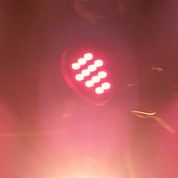 semiconductor device which emits light when a current
flows through it. The general idea is that as
electrons move through the semiconductor material, they
will suddenly lose energy, due to the structure of the
material. These energy losses happen in jumps: a
certain packet of energy will be lost at one jump, and
the energy thus released emerges as light. The exact
amount of energy determines the color of the light.
Each LED will give off light in a specific color,
because it is constructed so that the electron jumps
will contain just that amount of energy. Today LED
bulbs are available which give off multiple colors,
but these are actually tiny envelopes containing
several different LEDs, most generally red, green, and
blue which then combine to make other colors.
White LEDs are actually blue, with phosphor on the
inside of the envelope converting the blue light to
white. LEDs were first used in theater for decorative
purposes (star curtains, signs); however, in recent
years there has been a huge increase in efficiency, so
that today they are bright enough to be used in
lighting instruments. Dimming is done with an
electronic unit which connects to a DMX cable to a
lighting computer, where the LEDs can be called up
as channels (for instance, Channel 101 might be
red, Channel 102, green, and Channel 103, blue) or as
spots in lighting consoles for computerized lights.
semiconductor device which emits light when a current
flows through it. The general idea is that as
electrons move through the semiconductor material, they
will suddenly lose energy, due to the structure of the
material. These energy losses happen in jumps: a
certain packet of energy will be lost at one jump, and
the energy thus released emerges as light. The exact
amount of energy determines the color of the light.
Each LED will give off light in a specific color,
because it is constructed so that the electron jumps
will contain just that amount of energy. Today LED
bulbs are available which give off multiple colors,
but these are actually tiny envelopes containing
several different LEDs, most generally red, green, and
blue which then combine to make other colors.
White LEDs are actually blue, with phosphor on the
inside of the envelope converting the blue light to
white. LEDs were first used in theater for decorative
purposes (star curtains, signs); however, in recent
years there has been a huge increase in efficiency, so
that today they are bright enough to be used in
lighting instruments. Dimming is done with an
electronic unit which connects to a DMX cable to a
lighting computer, where the LEDs can be called up
as channels (for instance, Channel 101 might be
red, Channel 102, green, and Channel 103, blue) or as
spots in lighting consoles for computerized lights.
- Types of Fixtures
Instruments using LEDs today include:
- Par LEDs: theater
units containing between 18 and about 40 LEDs,
generally in red, blue and green, but often
with amber and/or white also included. These
might use only 40 Watts of electricity and be
as bright as a 500W Fresnel.
- Wash units: very useful for lighting scenery
and as footlights.
- LED Ellipsoidals:
available in multicolored units (for color mixing)
or in white (desireable mainly for their low
power consumption and long lamp life).
- Dimming
Dimming is not as smooth
as with incandescent lights, but it's
improving all the time. There are also moving
lights which use LEDs. These fixtures are also
discussed in our chapter on
Lighting Fixtures.
- Usage
LEDs are used today in lighting homes, buildings,
streets, and many other applications because
of their extremely low power consumption and
extremely long lamp life; average life of an
LED may be 10,000 hours, which is very
convenient in places where it's difficult to
change a lamp. This is not very important for
theater; however the low power consumption
can be useful. The colors themselves are
wonderfully pure, and LEDs are increasingly
used to replace units with color scrollers.
|
|